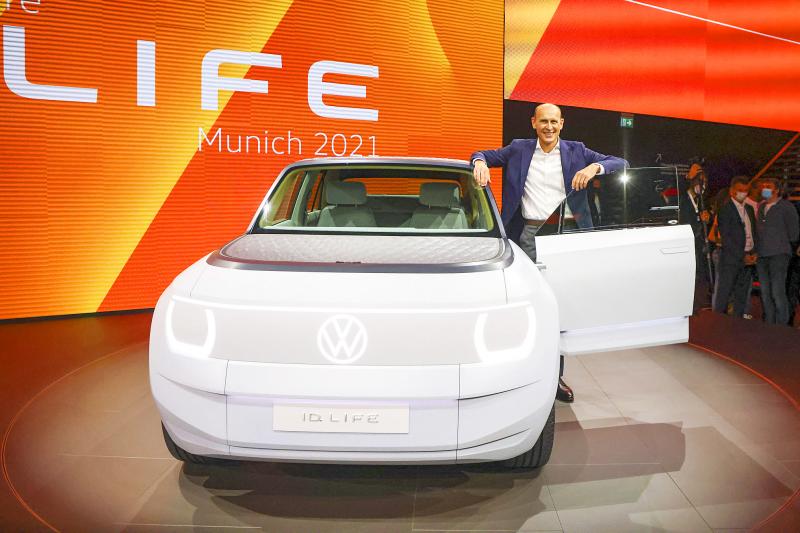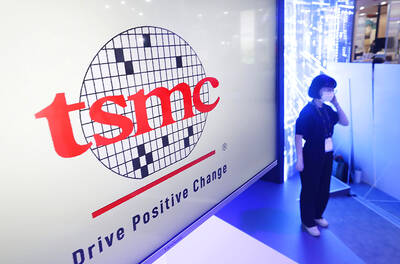As automakers scramble to make electric vehicles (EVs) with longer ranges and speedier charging times, the chip industry has a message for them: You are doing it wrong.
Semiconductor companies are urging EV makers to ditch traditional silicon chips and embrace materials that would make vehicles more efficient, helping ease consumers’ “range anxiety” and someday making recharges as quick as a gas-station fill-up.
However, there is not an agreement yet on which approach to use. Silicon carbide is the front-runner, with gallium nitride emerging as a key contender.

Photo: Bloomberg
What are these new materials? Well, silicon carbide — as the name suggests — is a combination of two elements: silicon and carbon. It does a better job as a power converter, meaning chips using the material can move energy around with less of it getting lost along the way.
The same is true of gallium nitride, which is made of gallium and nitrogen, and — like silicon carbide — has a distinct edge over traditional silicon. Proponents say that it could cut charging time in half.
Choosing the right technology has especially high stakes as the auto industry undergoes its biggest transformation in more than a century. Manufacturers around the world are racing to ditch internal combustion engines, and even icons of the gasoline age like Ford Motor Co’s Mustang and the GMC Hummer are getting versions with batteries.
Along the way, chips have become ever more critical to how a vehicle works, spanning everything from the powertrain to the air bags. That is become painfully apparent this year as automakers have had to limit production and leave dealer lots empty because they cannot find enough silicon.
However, getting automakers on board with the newer technologies is critical to raising EVs to the next level.
“It’s a big learning curve for the carmakers,” said Jean-Christophe Eloy, head of Yole Developpement, a semiconductor analysis firm in France. “A good battery, a good inverter and a good electric motor doesn’t give you a good electric car.”
The good news, Eloy says, is that Tesla Inc — a company that prodded the industry to embrace EVs in the first place — could help spur this transition as well.
Tesla is one of the first major adopters of silicon-carbide chips, supplied by STMicroelectronics NV, Eloy said.
Chief executive officer Elon Musk has touted the technology as a key advantage of his vehicles.
With silicon carbide, watts of power can be crammed into the battery much more quickly, cutting charge times, and it provides for longer ranges because there is less leakage — wasted power — as a vehicle taps the energy needed to drive motors.
Infineon Technologies AG, the biggest maker of automotive chips, expects silicon carbide to exceed more than 30 percent of the market in electric vehicle power chips by 2025.
“Silicon carbide can bring a significant advantage, literally a 5 percent to 10 percent improvement in range,” said Stephan Zizala, the head of Infineon’s automotive high-power solutions group.
Some manufacturers are already sold on the concept. General Motors Co (GM) is using silicon-carbide devices in its Ultium EV battery platform, the basis of all of its electric vehicles.
Toyota Motor Corp., which pioneered hybrid vehicles with the Prius, uses silicon carbide in the hydrogen-powered Toyota Mirai and its supplier Denso Corp has built the chips into other vehicle lines.
Stellantis NV, formed from the merger of Fiat Chrysler Automobiles NV and French rival PSA Group earlier this year, has said that it might use silicon carbide in power inverters that would be key to mass manufacturing a new generation of electric vehicles globally.
However, some companies, such as GM, are hedging their bets. They are also looking at gallium nitride, or GaN, for future use.
Gallium nitride is a newer entrant — and it is not yet clear what role it will play. Infineon expects it to complement other technologies. Others are positioning it as more of a rival to silicon carbide.
BMW AG last month signed a deal to secure US$250 million of such chips from GaN Systems Inc.
Gallium-nitride chips can cut the time it typically takes to charge a vehicle to 4.7 hours from 11.3 hours, saving 70 percent on energy in the process.
It could also boost the vehicle’s range by 5 percent and use fewer batteries.
That is according to start-up Navitas Semiconductor Inc, which is telling investors that gallium-nitride chips would account for 16 percent of the power semiconductor market by 2026, up from less than 1 percent last year.
Automakers have taken years to warm up to the new technologies. When silicon carbide was first offered to auto manufacturers more than a decade ago, they shunned it as “horribly expensive,” said Michael Duhaime, vice president of JJE North America, a Chinese-owned maker of electric drivetrains in Troy, Michigan.
The typical reaction at the time: “Why would I do that? It’s crazy,” he said.
Now it is making its way into premium vehicles, where cost is outweighed by the performance benefits.
However, there are still some painful trade-offs. Traditional silicon-based chips are made in the billions each year, and the technology’s 50 years of dominance has created a massive global infrastructure to produce it. That has brought costs down.
Silicon-carbide wafers, the basic material on which the new chips are built, are produced by only a few companies, such as Cree Inc, in a process that is still difficult and expensive.
One obstacle is the material itself, which has to be grown from seed crystals in a chemical process. There are relatively few crystals available that will produce the purity required. Any impurities can result in wafers and chips that are less efficient.
In a sign of how scarce the materials are, Cree rival On Semiconductor Corp in August agreed to pay US$415 million for GT Advanced Technologies, acquiring its supplier of silicon carbide. That deal lets it secure access to the raw material.
Silicon-carbide components could add an extra US$200 to the cost of a vehicle, according to an estimate by Cree.
However, proponents of the new technology say the cost would quickly be recouped, because vehicles would not need as many batteries.
That speaks to the need for automakers to put more thought into the chips they use, Eloy said.
“If you want to save costs, if you want to increase range, if you want to do all of this optimization, you need to have your hands in the semiconductors,” he said.

ADVANCED: Previously, Taiwanese chip companies were restricted from building overseas fabs with technology less than two generations behind domestic factories Taiwan Semiconductor Manufacturing Co (TSMC, 台積電), a major chip supplier to Nvidia Corp, would no longer be restricted from investing in next-generation 2-nanometer chip production in the US, the Ministry of Economic Affairs said yesterday. However, the ministry added that the world’s biggest contract chipmaker would not be making any reckless decisions, given the weight of its up to US$30 billion investment. To safeguard Taiwan’s chip technology advantages, the government has barred local chipmakers from making chips using more advanced technologies at their overseas factories, in China particularly. Chipmakers were previously only allowed to produce chips using less advanced technologies, specifically

BRAVE NEW WORLD: Nvidia believes that AI would fuel a new industrial revolution and would ‘do whatever we can’ to guide US AI policy, CEO Jensen Huang said Nvidia Corp cofounder and chief executive officer Jensen Huang (黃仁勳) on Tuesday said he is ready to meet US president-elect Donald Trump and offer his help to the incoming administration. “I’d be delighted to go see him and congratulate him, and do whatever we can to make this administration succeed,” Huang said in an interview with Bloomberg Television, adding that he has not been invited to visit Trump’s home base at Mar-a-Lago in Florida yet. As head of the world’s most valuable chipmaker, Huang has an opportunity to help steer the administration’s artificial intelligence (AI) policy at a moment of rapid change.

TARIFF SURGE: The strong performance could be attributed to the growing artificial intelligence device market and mass orders ahead of potential US tariffs, analysts said The combined revenue of companies listed on the Taiwan Stock Exchange and the Taipei Exchange for the whole of last year totaled NT$44.66 trillion (US$1.35 trillion), up 12.8 percent year-on-year and hit a record high, data compiled by investment consulting firm CMoney showed on Saturday. The result came after listed firms reported a 23.92 percent annual increase in combined revenue for last month at NT$4.1 trillion, the second-highest for the month of December on record, and posted a 15.63 percent rise in combined revenue for the December quarter at NT$12.25 billion, the highest quarterly figure ever, the data showed. Analysts attributed the

Taiwan Semiconductor Manufacturing Co’s (TSMC, 台積電) quarterly sales topped estimates, reinforcing investor hopes that the torrid pace of artificial intelligence (AI) hardware spending would extend into this year. The go-to chipmaker for Nvidia Corp and Apple Inc reported a 39 percent rise in December-quarter revenue to NT$868.5 billion (US$26.35 billion), based on calculations from monthly disclosures. That compared with an average estimate of NT$854.7 billion. The strong showing from Taiwan’s largest company bolsters expectations that big tech companies from Alphabet Inc to Microsoft Corp would continue to build and upgrade datacenters at a rapid clip to propel AI development. Growth accelerated for